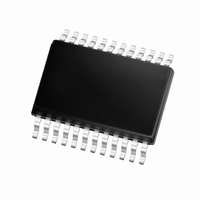MCP3905T-I/SS Microchip Technology, MCP3905T-I/SS Datasheet - Page 13

MCP3905T-I/SS
Manufacturer Part Number
MCP3905T-I/SS
Description
IC ENERGY METER 24-SSOP
Manufacturer
Microchip Technology
Datasheet
1.MCP3905-ISS.pdf
(26 pages)
Specifications of MCP3905T-I/SS
Input Impedance
390 KOhm
Measurement Error
0.1%
Voltage - I/o High
2.4V
Voltage - I/o Low
0.85V
Current - Supply
2.7mA
Voltage - Supply
4.5 V ~ 5.5 V
Operating Temperature
-40°C ~ 85°C
Mounting Type
Surface Mount
Package / Case
24-SSOP (0.200", 5.30mm Width)
Meter Type
Single Phase
Lead Free Status / RoHS Status
Lead free / RoHS Compliant
Available stocks
Company
Part Number
Manufacturer
Quantity
Price
Part Number:
MCP3905T-I/SS
Manufacturer:
MICROCHIP/微芯
Quantity:
20 000
If an external voltage reference source is connected to
the REFIN/OUT pin, the external voltage will be used
as the reference for both current and voltage channel
ADCs. The voltage across the source resistor will then
be the difference between the internal and external
voltage. The allowed input range for the external volt-
age source goes from 2.2V to 2.6V for accurate mea-
surement error. A V
cause additional heating and power consumption due
to the source resistor, which might affect measurement
error.
4.4
The MCP3905/06 contains an internal POR circuit that
monitors analog supply voltage AV
This circuit ensures correct device startup at system
power-up/power-down events. The POR circuit has
built-in hysteresis and a timer to give a high degree of
immunity to potential ripple and noise on the power
supplies, allowing proper settling of the power supply
during power-up. A 0.1 µF decoupling capacitor should
be mounted as close as possible to the AV
providing
Section 5.0 “Applications Information”).
The threshold voltage is typically set at 4V, with a
tolerance of about ±5%. If the supply voltage falls below
this threshold, the MCP3905/06 will be held in a Reset
condition (equivalent to applying logic ‘0’ on the MCLR
pin). The typical hysteresis value is approximately
200 mV in order to prevent glitches on the power
supply.
Once a power-up event has occurred, an internal timer
prevents the part from outputting any pulse for approx-
imately 1s (with MCLK = 3.58 MHz), thereby prevent-
ing potential metastability due to intermittent resets
caused by an unsettled regulated power supply.
Figure 4-3 illustrates the different conditions for a
power-up and a power-down event in the typical
conditions.
FIGURE 4-3:
© 2007 Microchip Technology Inc.
DEVICE
MODE
AV
4.2V
5V
4V
0V
DD
Power-On Reset (POR)
RESET
additional
PULSE
OUT
NO
1s
REF
Power-on Reset Operation.
value outside of this range will
OPERATION
transient
PROPER
DD
during operation.
immunity
RESET
DD
(see
Time
pin,
4.5
The active (real) power value is extracted from the DC
instantaneous power. Therefore, any DC offset
component present on Channel 0 and Channel 1
affects the DC component of the instantaneous power
and will cause the real-power calculation to be
erroneous. In order to remove DC offset components
from the instantaneous power signal, a high-pass filter
has been introduced on each channel. Since the high-
pass filtering introduces phase delay, identical high-
pass filters are implemented on both channels. The
filters are clocked by the same digital signal, ensuring
a phase difference between the two channels of less
than one MCLK period. Under typical conditions
(MCLK = 3.58 MHz), this phase difference is less than
0.005°, with a line frequency of 50 Hz. The cut-off
frequency of the filter (4.45 Hz) has been chosen to
induce minimal gain error at typical line frequencies,
allowing sufficient settling time for the desired applica-
tions. The two high-pass filters can be disabled by
applying a logic ‘0’ to the HPF pin.
FIGURE 4-4:
(MCLK = 3.58 MHz).
The multiplier output gives the product of the two high-
pass-filtered channels, corresponding to instantaneous
active (real) power. Multiplying two sine wave signals
by the same ω frequency gives a DC component and a
2ω component. The instantaneous power signal con-
tains the active (real) power of its DC component, while
also containing 2ω components coming from the line
frequency multiplication. These 2ω components come
for the line frequency (and its harmonics) and must be
removed in order to extract the real-power information.
This is accomplished using the low-pass filter and DTF
converter.
-10
-15
-20
-25
-30
-35
-40
-5
0
0.1
High-Pass Filters and Multiplier
1
MCP3905/06
HPF Magnitude Response
Frequency (Hz)
10
DS21948D-page 13
100
1000














